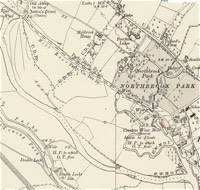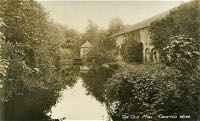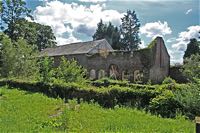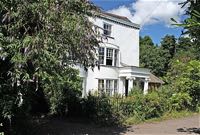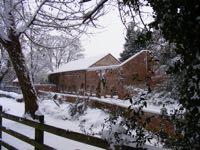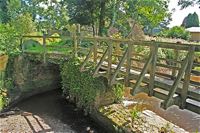
Countess Wear Paper Mills
Added 12th October 2015
Return to Industrial Exeter
The leat that taps off Salmon Pool Weir runs in a straight line parallel to the Exe. It was originally created to feed a mill for the Cluniac monks of the Priory of St James. The earliest record of a mill at Countess Wear, taking advantage of the power from this leat, is from circa 1638. In a document from the Exchequer Depositions, a deposition from Henry Peters confirms the erection of a mill at the site. A later deposition from Peter Trenchard, a paper maker, of St Thomas, states that he served an apprenticeship under Abraham Langdon at ‘Wear Paper Mills’ in about the year 1656. The mill at Countess Wear was quite late in the story of paper making in this country, as the earliest paper mill in England dates from 1490 in Stevenage, constructed by John Tate
A mill site could house several wheels, each performing a different function. For example, in 1757 there were two fulling mills, a leather mill, three grist mills, and one rape mill at Ware (Wear), Topsham. The multi-mill nature of the site is confirmed when in 1777, a Higher and Lower mill were mentioned, the first time two paper mills at Countess Wear are recorded.
Thomas Bond ran the paper mill in 1750, and put it up for sale in November 1773. An advert in the Exeter Flying Post stated:
"To be Sold in Fee, by private Contract, or Lett for a Term of Years, ALL that commodious new-built PAPER-MILL, fituate on the River Exe, between Exeter and Topfham, now in the poffeffion of Mr. Thomas Bond; confifting of one White Vatt, One Prefs-Paper Vat; one Hand Vatt, four Water-Wheels, and four new Glazing Engines, with Dry-Houfes, Lofts and every other convenience for carrying on the Paper-making Trade to great Advantage, with a very fine Spring of water for wafhing.
The Mills lie very commodious for Land or Water Carriage, as the Tide flows up to the door, and never want water in the drieft feafon.
There is a very good Dwelling-Houfe on the Premifes, with Stables, Outhoufes .. and the Purchafer or Tenant may have all the stock of Rags, Utensils &c ..’
For further particulars, Application may be made to Mr. Thomas BOND, on the Premifes ..."
The mills changed ownership several times over the years, as highlighted here. Thomas Chorlock from before 1782 owned the mills. Then a partnership between Thomas Warren and Thomas Chorlock was dissolved in 1791. By 1793, Charlock and Hill were listed as the partnership running the paper mill—their partnership was dissolved in 1795. In 1798, both the Lower and Higher mills were run by a partnership between Joseph Mackenzie, John Pim and Peter Mackenzie. However, in 1799, Thomas Chorlock still insured the mills, as he was the owner. After 1800 Hugh Oxenham and John Pim ran the mills. By 1805 they were insured jointly by Hugh Oxenham (paper maker) and Faith Chorlock (owner and widow of Thomas Chorlock).
Fire in the mill
The first of several fires occurred on Sunday 26 May 1806. It was rebuilt by 1832, when the partnership of Charles Harris and Edward Norish Tremlett formed to run the mill. Charles Harris dissolved his partnership with Tremlett in 1844.
Water wheels supplied the mechanical power for making paper — coal was also needed, and in a two month period in 1855, 800 tons of coal was landed by barge for use in the mill. In August 1856 it suffered another fire, destroying a rag store. At this time the mill was producing newsprint for the Times of india and paper for £5 notes. It wasn't until about 1850 that producing paper from wood pulp was perfected, and for the Countess Wear Mill, the importation of rags from Holland was reduced. However, the use of wood pulp dropped the price of paper, and was probably the reason why the mills output started to fall.
Charles Harris died in 1863, and the partnership was dissolved. A new partnership was formed between John Dewdney Harris and Richard Martyn. In 1869, thirteen years after the fire, John Martin Harris and his partner, Charles Martyn, constructed a new set of mills, and sold off some surplus stock. They had also started to use the railways to transport paper to their customers. By 1871, 28 workers we’re employed by Henry Martin, which had increased to 33 in 1881.
By 1880, Mr Henry Matthews Martyn was the proprietor, but business did not go well for he filed for bankruptcy in 1884, with the mill finally closing in 1885—the machinery was finally sold in 1894. In 1889 a report suggested that the cost of carriage made it difficult to compete with other paper mills, hastening its closure.
The city considered the site for a new sewage works in 1892, but did not proceed, keeping the existing works at Belle Isle open. The mill site was purchased by Percy Sladen in 1899, who occupied Northbrook Park. He converted a surviving wheel to generate electricity for his house, a job which it did until World War Two.
The mill gradually deteriorated after the war, until 2008, when it was restored and an interpretation sign was installed.
Sources: Many documents at the Devon Heritage Centre indexed by Ian Maxted. City directories and local newspapers.
│ Top of Page │
